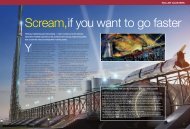Cisco - TABPI
Cisco - TABPI
Cisco - TABPI
Create successful ePaper yourself
Turn your PDF publications into a flip-book with our unique Google optimized e-Paper software.
NEWS&ANALYSIS<br />
Eric Lundquist: Up Front<br />
Golden-oldie lessons<br />
Vendors and prognosticators are either<br />
wringing their hands looking for the next big<br />
thing or worrying that IT has become a lowpriced<br />
commodity to be purchased like electricity<br />
or paper clips. They could learn a thing<br />
or two from mainframes, pay phones and backhoes.<br />
Here’s why. The mainframe business has been predicted<br />
to die ever since IBM developed the Model 704<br />
in 1957. Full-time venture capitalist and part-time Fortune<br />
columnist Stewart Alsop predicted that the last<br />
mainframe would be unplugged in 1996. This month,<br />
IBM once again proved Alsop’s and others’ predictions<br />
to be ludicrously off the mark by introducing the z990,<br />
code-named T-Rex. The advance of Intel-based microprocessors and Microsoft<br />
software was supposed to be the equivalent of the cataclysmic asteroid impact that<br />
wiped out the dinosaurs. It has been little more than a summer meteor shower.<br />
Why do mainframes continue to<br />
inhabit the planet? That they work as<br />
advertised is probably the immediate<br />
answer. The stories about old mainframes<br />
still cranking out reports and<br />
doing financials on some proprietary program<br />
written in the 1970s are legion. A<br />
second reason is that if you are willing<br />
to invest—say, about $1 billion over four<br />
years—you can make a mainframe<br />
that looks a lot like what IBM is selling.<br />
“We continue to invest in those features<br />
and capabilities our customers<br />
are asking for,” Peter McCaffrey, IBM’s<br />
director of product marketing for the<br />
zSeries of mainframes, told me. Combining<br />
the reliability and scale of mainframes<br />
with recent developments such<br />
as Linux has created an alluring platform<br />
for e-commerce.<br />
What’s more, working on a platform<br />
that pundits are forever declaring extinct<br />
has proved motivational to IBM engineers.<br />
“Every once in a while, they<br />
have a good laugh over it. In the end, it<br />
drives our engineers to constantly reinvent<br />
the platform,” said McCaffrey.<br />
26 eWEEK n MAY 26, 2003<br />
Now, pay phones. They are ubiquitous<br />
and yet underused in this era of cell<br />
phones. When Intel introduced its<br />
wireless chips under the Centrino<br />
label, it produced a movie, ostensibly<br />
humorous, that included a spoof on<br />
pay phones. Now, Verizon is striking<br />
back by adding wireless hot-spot capabilities<br />
to its pay phones. Starting in New<br />
York, Verizon is making hot-spot access<br />
for 802.11-enabled devices free for Verizon<br />
Internet access customers.<br />
This is a smart move for Verizon<br />
and a challenge to all those venture<br />
capitalists who were betting on the<br />
vendors of equipment you’d need to be<br />
wirelessly logging on at McDonald’s as<br />
you scarf down your Big Mac. Philip Nutsugah,<br />
executive director for broadband<br />
wireless at Verizon, said the company<br />
intends to have 1,000 pay phone hot spots<br />
in New York by year’s end.<br />
Now take a guess what the following<br />
quote refers to. “Every feature was<br />
designed with productivity, serviceability<br />
and reliability in mind.” No, it’s not<br />
Scott McNealy trying to persuade you to<br />
buy more Solaris, and it’s not Bill<br />
Gates contending he finally has the security<br />
thing under control. The quote was<br />
part of a press release for the new John<br />
Deere 710G backhoe introduced in<br />
January and replete with new features<br />
and technologies. In a 1997 article on<br />
HotWired.com titled “50 Ways to Crash<br />
the Net,” security expert Simson Garfinkel<br />
included buying 10 backhoes as<br />
one of the 50. That’s because, back<br />
then, critical Internet backbones too<br />
often ran through underground cables,<br />
which too frequently fell victim to the<br />
digging of backhoes.<br />
When a backhoe blade sliced through<br />
a cable and cut off Internet access to a<br />
big chunk of Boston on May 13, I started<br />
to wonder if backhoe technology is evolving<br />
faster than the physical security of<br />
the Internet.<br />
I tracked down Garfinkel, now going<br />
for his doctorate at MIT. While it<br />
might take more than 10 backhoes to<br />
do the job now, the physical security<br />
of the Internet’s routers, name servers<br />
and associated hardware remains far<br />
too vulnerable for the elevated threats<br />
the Net faces, Garfinkel said. “There<br />
ERIC_ LUNDQUIST@ZIFFDAVIS.COM<br />
Why do mainframes continue to inhabit<br />
the planet? That they work as advertised<br />
is probably the immediate answer.<br />
is a very high risk of physical damage.<br />
People tend to forget about physical<br />
security,” he said.<br />
Part of progress is the illusion that we<br />
leave some things behind. But some<br />
golden-oldie technologies stick around<br />
for a reason. They’re good at what they<br />
do. Still, that backhoe technology remains<br />
one step ahead of Internet architects<br />
should give us all pause. ´













